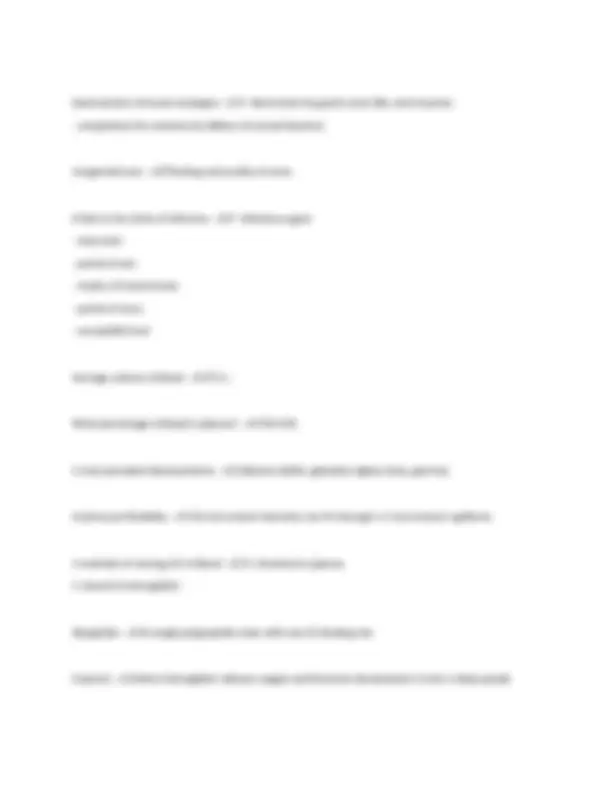








Study with the several resources on Docsity

Earn points by helping other students or get them with a premium plan


Prepare for your exams
Study with the several resources on Docsity

Earn points to download
Earn points by helping other students or get them with a premium plan
Community
Ask the community for help and clear up your study doubts
Discover the best universities in your country according to Docsity users
Free resources
Download our free guides on studying techniques, anxiety management strategies, and thesis advice from Docsity tutors
A comprehensive set of questions and answers related to pathogenicity, virulence, and infectious disease mechanisms. It covers key concepts such as infectivity, toxigenicity, antigenicity, and pathogenic defense mechanisms. Additionally, it includes information on various pathogens, their associated diseases, and immune strategies. The material is presented in a question-and-answer format, making it useful for exam preparation and review. It also touches on topics like hemostasis, inflammation, and cell injury, offering a broad overview of essential medical microbiology and immunology concepts. Designed to help students understand the fundamental principles of how pathogens cause disease and how the body responds to infection, providing a solid foundation for further study in related fields. It is a valuable resource for medical and nursing students.
Typology: Exams
1 / 11

This page cannot be seen from the preview
Don't miss anything!







Pathogenicity - ✔✔qualities that promote the production of disease Virulence - ✔✔potency of the pathogen indicated by the ratio of the number of cases compared to number of exposures Infectivity - ✔✔proportion of exposures needed to cause infection in an individual Toxigenicity - ✔✔ability of the pathogen to produce harmful toxins that increase host cell and tissue damage Antigenicity - ✔✔level to which a pathogen is viewed by the host immune system as foreign Antigenic variability - ✔✔process of eluding the human host defenses, often consists of altering antigen presentation Pathogenic defense mechanisms - ✔✔ways in which a pathogen has developed to avoid destruction by host Coinfection - ✔✔hosting two or more pathogens simultaneously Superinfection - ✔✔when an infection arises in addition to one that is already present Endotoxin - ✔✔complex of phospholipid-polysaccharide molecules that form the structural component of the gram-negative cell wall, causes inflammatory response when bacterium is lysed Exotoxins - ✔✔potent substances that result in host cell dysfunction or lysis
Neisseria meningitidis - ✔✔meningitis Streptococcus pyogenes - ✔✔- septicemia
Transmission of protozoa - ✔✔- sexual contact
Pathogens - ✔✔disease-producing microbes Horizontal spread - ✔✔one individual infects others, insect vectors, etc. Vertical spread - ✔✔parents to offspring via sperm, ovum, placenta, milk Eye immune strategies - ✔✔washing and antibiotic activity of tears Lymph node immune strategies - ✔✔phagocytosis by macrophages, attack by natural killers cells Skin immune strategies - ✔✔physical barrier Respiratory immune strategies - ✔✔- entrapment by mucus
Gastroenteric immune strategies - ✔✔- destruction by gastric acid, bile, and enzymes
to which region of the lymph node do B cells migrate? - ✔✔cortex and medulla to which region of the lymph node do T cells migrate? - ✔✔paracortex atrophy - ✔✔decrease in the size of cells hypertrophy - ✔✔increase of cell size (trophic signaling) hyperplasia - ✔✔increase in cell number metaplasia - ✔✔swapping of one cell type for another dysplasia - ✔✔change in cell size, shape, uniformity, arrangement, and structure autophagy - ✔✔mechanism by which the cell 'eats itself' by digesting its own organelles necrosis - ✔✔cell death with lysis of membrane, leads to inflammation apoptosis - ✔✔programmed cell death with intact membrane, no secondary inflammation pyroptosis - ✔✔inflammatory cell death What percentage of your weight is total body water (TBW)? - ✔✔60% at steady state, how do extracellular fluid osmolality and intracellular osmolality compare? - ✔✔they are equal osmolarity - ✔✔number of solute particles per L of water, it is temperature dependent
osmolality - ✔✔mols per kilogram of water factors that change ECF and ICF - ✔✔- ingestion of water